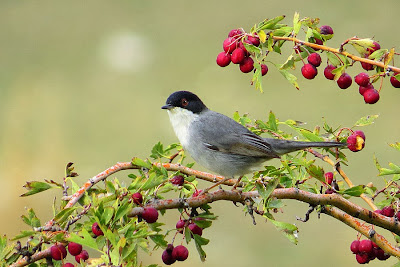A colossus in our mountains! With a wingspan of 2.8 metres and weighing 8 kilos, that’s 9 foot and 17lbs in old money, Griffon Vultures Gyps fulvus is our largest resident raptor here in the Serranía de Ronda and Sierra de Grazalema. Essentially a specialist carrion eater, this enormous bird is spectacular and the most easily seen raptor in our mountains.
Note: Polytypic. Nominate fulvus, North Africa, south and south-east Europe, south-west Asia south to Sinai, Arabia, and north-west Pakistan, and central Asia from Tadzhikistan to the Altai. Extralimital: fulvescens, from Sind and Kashmir through north and central India to Assam, north to Himalayan foothills.
 |
| The feeding frenzy |
Status and Fact File: Common resident. Although widespread throughout the province, it can be absent to very scarce in some areas (at least outside of periods for migration). Highest density of breeding birds is in the Cádiz and Málaga provinces. Numbers greatly increased during autumn migration period, as more northerly birds, mostly juveniles, migrate southwards. Some evidence to support local juveniles also migrate to Africa. Population remains artificially high, maintained by various feeding areas. Although relatively widespread, range is somewhat restricted due to the need for high cliffs or mountains for breeding and roosting. The only similar species likely to cause identification difficulties is Rüppell's Vulture Gyps rueppellii, now an annual visitor to the area and certainly in the Serranía de Ronda it has been observed during each month of the year.
 |
| Aggression display - territorial dispute |
Throughout Spain, this species has increased steadily over the past 15 years by the provision of feeding stations, the last official census carried out to ascertain the number of breeding birds put the population at 17,000 pairs. EU legislation threatened the status quo with the banning of artificial feeding stations. With the advent of mad cow disease (BSE), legislation was introduced requiring all dead carcases to be incinerated limiting the possibility of any further cross-contamination of this disease. The affect upon many areas was a disaster for Griffon Vulture populations and other carrion eating birds. In fact, some Griffon Vultures, normally a placid bird, took to attacking livestock where feeding stations were closed! Happily, due to pressure from various conservation and agricultural organisations, feeding stations are now to permitted again and are regulated to include fenced off compounds sited more than 500 metres away from human habitation. Of course all carcasses will have to have been tested negative for BSE!!!
 |
| Comical pose - cautious approach before tackling a carcass |
Many visitors (and possibly those living in the area) find identification of raptors difficult and confusing. With 4 breeding species of eagle and other large raptors in the area, then I think this is not surprising! However, as far as our Griffon Vultures are concerned, identification is made less difficult if we take account of its unique flight silhouette. Next time you see this bird in flight, either at close quarters or in the distance, make a note of the almost total lack of tail in relation to overall size. The depth of wing (leading to trailing edge) is very much greater than tail length. In many other raptors the tail is as long as the depth of wing. You could say, when in the air, Griffon Vultures look rather like a huge flying moustache!
 |
| Leaving the roost |
 |
| The gentle giant - beauty is in the eye of the beholder! |
Why not join Peter on one his Day Tours? See Links below.
Serranía de Ronda – My Mountains – for further information read HERE
Osuna – Steppe Country – for further information read HERE
Campillos - Mountains to Lagoons - for further information read HERE
 |
| Wildlife Guides you can trust - Leading you closer to nature |








































a.jpg)







